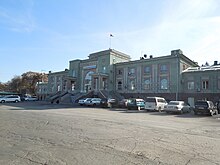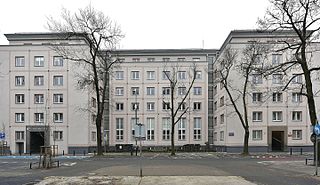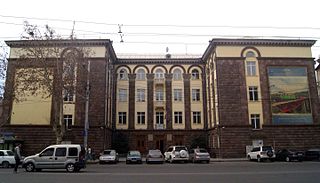

The Kyrgyz Railway (KTJ) is the national railway developer of Kyrgyzstan.


The Kyrgyz Railway (KTJ) is the national railway developer of Kyrgyzstan.
Kyrgyz Railway operates about 320 km of single track lines (with a total track length of 428 km). After the Soviet Union broke up, Kyrgyz Railways obtained 2,500 freight cars, 450 passenger cars and 50 locomotives from the Soviet railways. [1] However, the 1998 financial crisis drastically reduced spending on the railways. [1]
The current rail network is based on the inheritance from the former Soviet Union and as such has a broad gauge of 1,520 mm (4 ft 11+27⁄32 in).
Freight traffic is now only 13% of its 1990 level, 330 million tkm in 2001, compared to 2,620 million tkm in 1990 and is still falling. Passenger traffic is only about 25% of what it was in 1990. While freight services are profitable, passenger services are losing money, since fares are regulated by the Anti-Monopoly Committee, [1] and travel is due to long distances and slow railways partly taken over by air travel. Also, the line which once linked Bishkek and Osh became untenable once the complex post-Soviet borders in the Fergana Valley became less permeable in the later 1990s: the 'domestic' route had looped around through Tashkent (Uzbekistan) and Khujand (Tajikistan) crossing newly internationalized frontiers nine times.
In 2008 it was announced that work will commence on the electrification of the line which connects the capital Bishkek with the Kazakhstan railway network. [2] As of 2021, [update] work has not begun yet.

Transport in Kyrgyzstan is severely constrained by the country's alpine topography. Roads have to snake up steep valleys, cross passes of 3,000 m (9,843 ft) altitude and more, and are subject to frequent mud slides and snow avalanches. Winter travel is close to impossible in many of the more remote and high-altitude regions. Additional problems are because many roads and railway lines built during the Soviet period are today intersected by international boundaries, requiring time-consuming border formalities to cross where they are not completely closed. The horse is still a much used transport option, especially in rural and inaccessible areas, as it does not depend on imported fuel.

The transport network of the Russian Federation is one of the world's most extensive transport networks. The national web of roads, railways and airways stretches almost 7,700 km (4,800 mi) from Kaliningrad in the west to the Kamchatka Peninsula in the east, and major cities such as Moscow and Saint Petersburg are served by extensive rapid transit systems.

Most of rugged Tajikistan's transportation system was built during the Soviet era, and since that time the system has deteriorated badly because of insufficient investment and maintenance. In 2013, Tajikistan, like many of the other Central Asian countries, was experiencing major development in its transportation sector. Beginning in 2005, a series of major transportation projects begun. The first such project, the Anzob Tunnel, was inaugurated in 2006, providing a year-round road link from Dushanbe to northern Tajikistan.

Kyrgyzstan, officially the Kyrgyz Republic, is a landlocked country in Central Asia, lying in the Tian Shan and Pamir mountain ranges. Bishkek is the capital and largest city of the country. Kyrgyzstan is bordered by Kazakhstan to the north, Uzbekistan to the west, Tajikistan to the south, and China to the east and southeast. Ethnic Kyrgyz make up the majority of the country's seven million people, followed by significant minorities of Uzbeks and Russians.
The Trans-Asian Railway(TAR) is a project to create an integrated freight railway network across Europe and Asia. The project is of the United Nations Economic and Social Commission for Asia and the Pacific (UNESCAP).

Osh is the second-largest city in Kyrgyzstan, located in the Fergana Valley in the south of the country and often referred to as the "capital of the south". It is the oldest city in the country and has served as the administrative center of Osh Region since 1939. The city has an ethnically mixed population of 322,164 in 2021, comprising Kyrgyz, Uzbeks, Ukrainians, Koreans, and other smaller ethnic groups. It is about 5 km from the Kyrgyzstan-Uzbekistan border. It is known for famous islamic scholar.

With railways, a break of gauge occurs where a line of one track gauge meets a line of a different gauge. Trains and rolling stock generally cannot run through without some form of conversion between gauges, leading to passengers having to change trains and freight requiring transloading or transshipping; this can add delays, costs, and inconvenience to travel on such a route.

The Islamic Republic of Iran Railways is the national state-owned railway system of Iran. The Raja Passenger Train Company is an associate of the IR, and manages its passenger trains. The Railway Transportation Company is an associate of the IR, which manages its freight transport. The Ministry of Roads & Urban Development is the state agency that oversees the IRIR. Some 33 million tonnes of goods and 29 million passengers are transported annually by the rail transportation network, accounting for 9 percent and 11 percent of all transportation in Iran, respectively (2011).

Railways with a railway track gauge of 5 ft first appeared in the United Kingdom and the United States. This gauge became commonly known as "Russian gauge", because the government of the Russian Empire chose it in 1843. Former areas and states of the Empire have inherited this standard. However in 1970, Soviet Railways re-defined the gauge as 1,520 mm.
Kazakhstan Temir Zholy, also National Company Kazakhstan Temir Zholy, is the national railway company of Kazakhstan.
Dostyk or Druzhba is a small town in Kazakhstan's Jetisu Region, on the border with Xinjiang, China. It is a port of entry from China. The rail portion serves as an important link in the Eurasian Land Bridge. It is situated in the Dzungarian Gate, a historically significant mountain pass.

Bogie exchange is a system for operating railway wagons on two or more gauges to overcome difference in the track gauge. To perform a bogie exchange, a car is converted from one gauge to another by removing the bogies or trucks, and installing a new bogie with differently spaced wheels. It is generally limited to wagons and carriages, though the bogies on diesel locomotives can be exchanged if enough time is available.

Afghanistan has three railway lines in the north of the country. The first is between Mazar-i-Sharif and the border town of Hairatan in Balkh province, which then connects with Uzbek Railways of Uzbekistan. The second links Torghundi in Herat province with Turkmen Railways of Turkmenistan. The third is between Turkmenistan and Aqina in Faryab province of Afghanistan, which extends south to the city of Andkhoy. The country currently lacks a passenger rail service, but a new rail link from Herat to Khaf in Iran for both cargo and passengers was recently completed. Passenger service is also proposed in Hairatan – Mazar-i-Sharif section and Mazar-i-Sharif – Aqina section.

The Polish railways network consists of around 18,510 kilometres (11,500 mi) of track as of 2019, of which 11,998 km (7,455 mi) is electrified. The national electrification system runs at 3 kV DC.

Georgian Railway LLC is the national railway company of Georgia.

The Organization for Cooperation of Railways, was established as the equivalent of the International Union of Railways (UIC) to create and improve the coordination of international rail transport. Concerning especially the transports between Europe and Asia, it has helped develop cooperation between railway companies and with other international organisations. The members of this organisation created an international transport law.

Rail transport in Tajikistan is limited, as the railroad system totals only 680 kilometres (420 mi) of non-electrified, single-track railway, all of it 1,520 mm broad gauge. The system connects the main urban centres of western Tajikistan with points in neighboring Uzbekistan. In 1999 a new line connected the southern cities of Bokhtar and Kulob. In 2016, another line connected both cities to the capital Dushanbe, thus linking southern and central railway networks together. The northern branch around Khujand remains physically disconnected from this main Tajik railway network, accessible only through a lengthy transit via Uzbekistan. As of 2017, the passenger service remains limited to infrequent international trains from Dushanbe and Khujand to Moscow, one weekly train from Dushanbe to Khujand as well as a local service between Dushanbe and Pakhtaabad (daily) and Kulyob/Shahrtuz.

Azerbaijan Railways is the national state-owned rail transport operator in the Republic of Azerbaijan. The 2,918 km (1,813 mi), 1,520 mm gauge network is electrified at 3 kV (3,000 V) DC. The headquarters of the Azerbaijan Railways is in the capital Baku.

Much of the influence of the Soviet Union can be seen in the infrastructure of Central Asia. Central Asia is a nexus of said infrastructure for transportation, goods delivery and energy distribution. Much of the industrial infrastructure had greatly declined in the 1990s, after the fall of the Soviet Union, especially in Kyrgyzstan and Tajikistan. The roads, railroads and energy lines are thus oriented towards the Russian Federation and away from other regional neighbors, such as China, Afghanistan or Iran.

South Caucasus Railway is the sole railway company in Armenia, owned by Russian Railways, responsible for all inter-city, commuter, and freight rail transport in Armenia. The network consists of 780 kilometers of track with all lines in the Russian gauge.